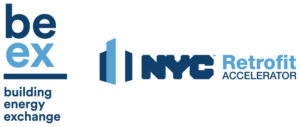Air Sealing for Room Air Conditioners
Low-cost measures to increase cooling efficiency and improve the building envelope.
Tech Overview
Applicable Buildings Types all multifamily, commercial
When to Implement anytime
*Be sure to consult a qualified service provider to determine the right measures for your building.
What is Air Sealing for Room Air Conditioners?
Room air conditioners (ACs) are compact electrical appliances commonly found in New York City that remove heat and moisture from indoor spaces. Window units are installed within open window frames, while sleeve and PTAC units are installed in wall penetrations, typically located below windows. All three styles create gaps in the building envelope (the barrier between the inside and outside of a building) that provide pathways for air, heat and moisture to both infiltrate and exfiltrate the building, which negatively impacts comfort and energy performance.
By adopting a small number of inexpensive maintenance routines to ensure gaps around ACs are well sealed, room ACs can improve comfort and save energy by providing efficient and effective cooling.

Fig 1. (Left) Typical Window AC (exterior view) Fig 2. (Center) Typical Sleeve AC (exterior view) Fig 3. (Right) Typical PTAC (interior view)
How to Implement
Sealing the gaps around each AC unit as well as implementing a simple but consistent maintenance routine will improve room AC performance and reduce air and moisture infiltration. Download the full tech primer to learn more about each of the following steps:
A. Conduct a Survey to collect information on the total number and types of AC units used throughout the building, the condition of AC sleeves, and seasonal AC installation/removal by tenants
B. Seal All AC Units in order to minimize air and moisture leakage through the gaps in between the building envelope and the AC unit
C. Establish a Season Maintenance Policy to avoid serious air leaks and drafts in the winter months by encouraging tenants to remove or cover their AC units
D. Engage End Users and maximize efficiency by providing training that includes instructions on how to operate each type of AC unit and identifying poorly installed units and improper AC use
Cost and Benefits
Cost and benefits of air sealing room ACs will vary depending on your building’s baseline systems and conditions. Typically, buildings can expect to see the following results:
Greenhouse Gas (GHG) Savings
A small amount of GHG savings can be achieved by sealing room ACs and implementing a maintenance routine.
Tenant Experience Improvement
Room Ac installation improvements moderately increase tenant satisfaction.
Utility Savings
A small amount of utility savings can be achieved by implementing a room AC optimization program.
Capital Cost
The cost of sealing AC units is low but time consuming.
Maintenance Requirement
Keeping room AC units performing at their best requires simple but consistent maintenance involving air sealing.
Take Action
This information is part of more than a dozen High Performance Technology Primers prepared by the Building Energy Exchange and the Retrofit Accelerator to introduce decision-makers to solutions that can help them save energy and improve comfort in their buildings. Curious about other retrofitting possibilities? Explore our complete library of Tech Primers here.
The NYC Retrofit Accelerator’s team of Efficiency Advisors offers free, personalized advisory services to help streamline the process of making energy efficient improvements to your buildings.
Get in touch with the NYC Retrofit Accelerator today!
Call (212) 656-9202
Visit nyc.gov/RetrofitAccelerator
Email info @nycretrofit.org
